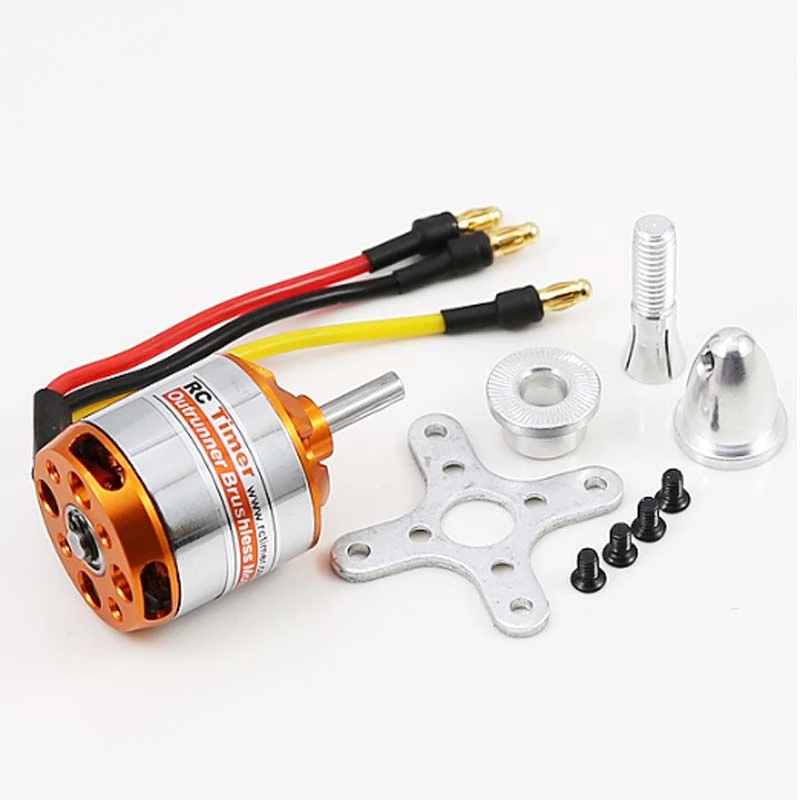Understanding a brushless DC motor characteristics
June 2nd, 2021 6:56 PM Mr. Q Categories: Motor, Remote Control (RC)
When purchasing a brushless DC electric motor (BLDC motor or BL motor), there are so many choices, which one is best for me?

First off, what are the terms and parts:
- Stator is the iron core the copper wires are wound on.
- Rotor is what the permanent magnets are attached to.
- Hall ICs are optional, they detect the rotor position.
- Housing is the metal case for the rotor.
- Outrunner vs Inrunner, refer to motor sizes, later in this post.
- 3 phase means you need a driver circuit such as a Electronic Speed Controller (ESC).
- S value refers to the number of 3.7V batteries it can handle.
Now a motor example: D2822/T12 1450kV is a mouth full, so lets break it down:
28 is the stator diameter.
22 is the stator height, the actual part next to the internal magnets.
T12 is the number of wire turns around the stator which is often left off of the description. It’s easy enough to calculate, we will review later.
kV refers to R.P.M./Volt. It is how motors are rated, and does not mean kiloVolts. If we have a 24V electronic speed controller (ESC), the speed will be 24 times that number of turns. The higher the kV rating the faster the R.P.M of the motor. The lower the turns, the higher the R.P.M. of the motor.
Buying a new brushless motor for our r/c car, robot, or mechanical applications, it’s a bit confusing why the motors are interpreted by kV rating or Turns (T)?
Turns and kV rating. kV tell us the relationship to the power out from a motor. kV describes the RPM (revolutions per minute) a motor does per Volt that is put into it.
The number of turns indicates how many times a wire is wrapped inside the motor. A higher turn number means more wire and thus more resistance, resulting in a slower motor. So turns with a lower number means a faster motor. The turn rating is inversely proportional to the power generated by the motor. A 4.5T motor is faster than a 21.5T motor per volt.
Now you need to make sure we choose the right Turn rating for your project. Using an R/C car as an example; lower T values, like 4.5T, will results in a much faster car, as the torque is lower but the kV will be higher. Higher T values, like 27T, will be a higher torque, lower kV motor. Crawlers would usually use a high T-rating motors, while touring cars and drift cars would go with low T-rating motors. Below gives you a general idea of the amount of Turns being generated to RPM:
| Turns | Approx. RPM per Volt |
|---|---|
| 3.5T | ~10,500 |
| 4.5T | ~9,000 |
| 5.5T | ~7,400 |
| 6.5T | ~6,400 |
| 7.5T | ~5,800 |
| 8.5T | ~5000 |
| 10.5T | ~4,200 |
| 13.5T | ~3,300 |
| 17.5T | ~2,200 |
| 21.5T | ~1,800 |
13.5T means ~3300 RPM PER VOLT. Each volt will give you 3300 rpm. Ten volts will give you ~33,000 rpm.
Lower kV motor allows you to run higher volt which allows you to run higher watts without having to increase current so much. Increasing current means more cooling, thicker cables etc. Power is measured in watt and strength in newton meter, (e.g 2435 motor is 24 x 35mm vs a 4074 motor which is 40 x 74mm and so on.
Review the power on amps the motor pulls and what volt is maximum and from there calculate the power in watts (P=UI). Example a 100A motor that runs on 6S lipo (22,2V) will produce up to 2200W while a 25A motor on 2S will produce up to 185W.
What have we not talked about yet:
The overall height is often left off of the description so we need to find the data sheet. This is important to me as it could slightly change the CG of a winged aircraft, but does not effect a drone. It could also impact the location of the motor in a buggy.
The difference between Inrunner & Outrunner. Brushless outrunner motors will have a larger diameter and a smaller length and provide more torque vs a comparable inrunner motor of similar weights. Conversely, Inrunners are smaller in diameter and typically larger in length. You can think of it as short and fat or tall and skinny.
If we look at the brushless outrunner motor, heat must be dissipated through the center of the motor. The source of heat generation is from the stator windings of the motor. The stator windings of the outrunner is located at the core of the motor. heat must transfer from the windings to the center of the motor being the motor shaft. Heat is then conducted outward through the motor shaft. An outrunners solution to heat is to have large accessible cooling vents in the case to allow air to flow over the windings directly.
Let me know your thoughts.
References
- https://en.wikipedia.org/wiki/Brushless_DC_electric_motor
- https://www.radiocontrolinfo.com/brushless-inrunner-vs-outrunner-motor/
- http://www.bavaria-direct.co.za/scheme/common/
- http://www.bavaria-direct.co.za/info/